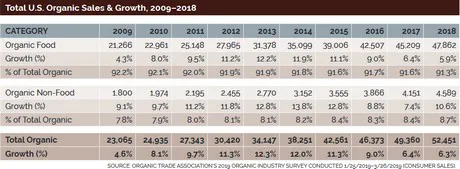The U.S. organic market in 2018 broke through the $50 billion mark for the first time, with sales hitting a record $52.5 billion, up 6.3 percent from the previous year, according to the 2019 Organic Industry Survey released Friday by the Organic Trade Association.
New records were made in both the organic food market and the organic non-food market. Organic food sales reached $47.9 billion, for an increase of 5.9 percent. Sales of organic non-food products jumped by 10.6 percent to $4.6 billion. The growth rate for organic continued to easily outpace the general market: in 2018, total food sales in the U.S. edged up just 2.3 percent while total non-food sales rose 3.7 percent.

Click here for a larger version.
Almost 6 percent (5.7 percent) of the food sold in this country is now organic. Today’s consumers can find organic products – food and non-food items -- in every aisle of their grocery stores. They can choose organic in their favorite big box store, their club warehouse store, even in their neighborhood convenience store, and increasingly on the internet. Organic is no longer a niche market.
“Organic is now considered mainstream. But the attitudes surrounding organic are anything but status quo,” said Laura Batcha, CEO and Executive Director of the Organic Trade Association. “In 2018, there was a notable shift in the mindset of those working in organic toward collaboration and activism to move the needle on the role organic can play in sustainability and tackling environmental initiatives.”
“Activism is a natural reaction from an industry that is really close to the consumer. When we are in an environment where government is not moving fast enough, the industry is choosing to move to meet the consumer rather than get stalled,” said Batcha.
Produce still reigns supreme
Still the stalwart of the organic industry, sales of organic fruits and vegetables rose to $17.4 billion in 2018 for a 5.6 percent rate of growth, on par with the growth attained in 2017. By comparison, the overall fruits and vegetables category, including both organic and conventional products, grew by just 1.7 percent in 2018.
Fruits and vegetables now account for 36.3 percent of all organic food sales. Organic fruits and vegetable make up close to 15 percent (14.6 percent) of all the produce sold in the U.S., and have nearly doubled their market share in the last ten years.
Produce is a gateway to organic for consumers, especially Millennials and those with young families. Industry experts note that the more people learn about health and wellness, the more people buy fresh produce.
Popular in the organic produce aisles: the classics like carrots, greens, apples, bananas. Also hitting stride are organic berries, avocados, Brussels sprouts, cauliflower and tropical fruits like mangoes and papayas. And outside the fresh produce section, the frozen, canned, and dried vegetable and fruit sections also made gains.
This year’s survey was conducted from January through April 2019 and produced on behalf of the Organic Trade Association by Nutrition Business Journal (NBJ). More than 200 companies completed a significant portion of the in-depth survey.
For more information: Organic Trade Association
Organic Trade Association
444 N. Capitol St. NW, Suite 445A
Washington D.C. 20001
T: 202-403-8520
www.ota.com
